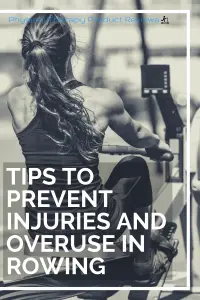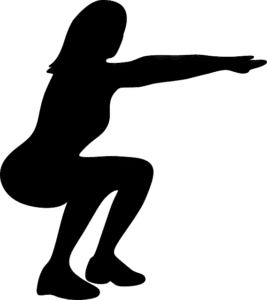 Rowing is a full-body workout effective for tackling both strength and cardio. From the outside looking in, you might think it’s only an arm workout. The many benefits of rowing include:
Rowing is a full-body workout effective for tackling both strength and cardio. From the outside looking in, you might think it’s only an arm workout. The many benefits of rowing include:
- Working out the lumbar musculature, pectorals, abdominal muscles, and large leg muscles.
- Strengthening the whole cardiovascular system and supporting the more efficient transportation of oxygen and nutrients throughout the body.
- Providing a low impact workout. It’s a perfect workout for those with joint problems.
Rowing does have a ton of benefits, but they’re not without risk. Common rowing injuries generally occur from overuse or improper technique. You can lower your risk of injury by following the guidelines laid out below.
Improper Rowing Technique
Overuse Of The Arms
Many people over-utilize their arms with the pulling motion in rowing. When done correctly, this motion requires the use of your full body. Instead of relying solely on your arms, you should be following through with the push using your legs.
The ‘perfect’ distribution of muscle use with rowing is:
- 60% legs
- 20% abs
- 20% arms
Slouching on the Rower
Posture is always important, but it is extremely important in rowing. Pay close attention to your posture the next time you Row. Monitor and make sure you:
- sit tall with a stacked posture
- use your abdominal muscles
- relax your shoulders for a more powerful position
Order of Proper Rowing Technique
Many people fire the arms and the legs at the same time. Doing this puts unnecessary strain on your upper body. Instead, think of ‘the stroke’ as a three-step process.
- Push with your legs.
- Pivot your hips backward
- Pull your arms into your chest.
Reverse the order to get back to the starting position.
Our Favorite Rowing Machine for Home
Our favorite rowing machine for home use is the Bluefin Fitness Rower. We love it for the quality that the rower offers at a reasonable price. Some of the important details include:
- Magnetic resistance with 8 levels of tension
- Foldable and easy storage for anyone
- Comes with live video streaming, video coaching, and a smartphone app
- LCD screen with all the bells and whistles: measures time, distance, calories burned & strokes per minute
Correct Rowing Technique
Common Injuries Associated with Rowing
Improper rowing technique can cause pain and possible injuries in the long term. If not addressed, these errors can negatively impact:
- the wrist
- forearm
- knees
- lower back
Below are the most common injuries caused by poor rowing form.
Extensor Tenosynovitis
Overuse of your arms leads to an overuse of the extensors of your wrist and hand. This creates an inflammation of the tendons, which causes pain, swelling, and creaking. This will cause intense pain while rowing and completing other daily activities.
Patellofemoral Syndrome
With poor order of operations, the knees take a hit. This causes pain just below the knee cap (aka patellofemoral syndrome). You’ll most likely start to experience pain when walking or climbing stairs.
Disc Injuries and Lower Back Pain
Lower back pain is one of the most severe injuries caused by rowing, secondary only to a disc issue. Maintaining poor posture while rowing or under-utilizing your core places undue stress on your lower back. Poor mechanics in the spine often leads to an injury. Disc injuries may present themselves as pain that radiates down into the buttocks. You might also experience spasms in your lower back.
How To Prevent Rowing Injuries
Adding a few simple exercises to your gym routine can help decrease your chance of injury. Try a few of these exercises the next time you hit the gym.
Squats
Strengthening your quads helps reduce patellofemoral pain. Squats increase quad strength and help strengthen the large muscle groups of the legs, giving more stability to the joint.

For a good squat:
- Start with your feet hip-width apart.
- Drive your hips back.
- Start bending at the knees, making sure to keep your heels on the ground and your chest up.
- Lower down into your squat position. Your knees should stay behind your toes the whole time.
- Press into your heels and straighten your legs as you come back to stand.
- Repeat 10- 20 times.
Deadlift
Every rower should add deadlifts to their gym routine. This exercise improves leg strength along with core and postural muscle strength. Increased strength in these areas can help prevent some of the most common injuries in rowers.
You have many options for weight with a deadlift. You can choose dumbbells, medicine balls, or resistance bands. Choose what works for you. The deadlift is all about the form. Focus on slow and controlled movement while completing this exercise.

- Start with your feet hip-width apart and your mid-foot in line with whatever weight you choose.
- Grab your weight as you bend your knees coming into a good squat position.
- With your weight in hand, lift your chest and straighten the legs and spine as you come to a stand.
- At the top hold for a second with your hips and knees locked and engaged.
- As you return the weight to the floor, move your hips back while bending your knees.
- Repeat 10 times.
I Y T s
IYT’s combine three exercises into one, making it a great exercise for improving your posture while rowing.
- Starting with the ‘I’
- Begin on your stomach with your arms overhead and your thumbs facing up.
- Raise your arms straight up towards the ceiling, pinching your shoulder blades and engaging your scapular muscles as you come to the top.
- Slowly control the motion back to the ground.
- Continuing to the ‘Y’:
- Start on your stomach with your arms in a ‘Y’ position with thumbs facing upwards.
- Raise your arms while pinching the shoulder blades
- Control back to the ground.
- Lastly the ‘T’:
- Start on your stomach, bring your arms out to a ‘T’.
- Engage the scapular muscles between the shoulder blades and bring the arms off of the ground.
- Repeat each part 10 times. Try adding a dumbbell for some added resistance.
Planks
The plank exercise is a standard for core strengthening and should be added to help improve your posture and support your lower back with rowing.
- Use your forearms and toes to hold yourself up off the ground. Think about keeping a straight line from your head to your heels by engaging your glutes and abdominals.
- Simply hold this position for 30-60 seconds, 2-3x.
Stretching
With rowing, it is extremely important to add extensive stretching to your workout routine. Think about stretching your wrist extensors, glutes, pectorals, hamstrings, and torso to help decrease muscle tightness after your workout and hopefully decrease your chance of injury.
In Review
Overall, rowing has been proven to be a great whole-body workout. By training correctly, using proper technique, and incorporating these recommended workouts and stretches into your routine, you’ll be able to reap the full benefits of rowing.
Works Referenced:
Gee, T. I., Olsen, P. D., Berger, N. J., Golby, J., & Thompson, K. G. (2011). Strength and Conditioning Practices in Rowing. Journal of Strength and Conditioning Research, 25(3), 668-682. doi:10.1519/jsc.0b013e3181e2e10e
Maestu, J., Jurimae, J., & Jurimae, T. (2005). Monitoring of Performance and Training in Rowing. Sports Medicine, 35(7), 597-617. doi:10.2165/00007256-200535070-00005
McNally, E., Wilson, D. (2005). Rowing Injuries. Musculoskeletal Radiology, 9(4), 379- 388. doi:22.1419/jsc.0b045e3181e112
Other Great Rehab Related Articles
How to Stay Active After Cervical Fractures: Expert Tips and Advice
Dealing with Painful Stairs After Ankle Replacement Surgery
Walking After a Total Ankle Replacement: Tips for a Successful Recovery
Exercises While Non-Weight Bearing After Ankle Replacement: Elevation, AROM, Leg Raises, and More
Ankle Pain with Stairs: Causes and Home Treatment Options
5 Common Mistakes You’re Making After an Ankle Sprain
Disclaimer: The information provided in this post is for educational purposes only. This is not a substitute for a medical appointment. Please refer to your physician before starting any exercise program.









Comments are closed.